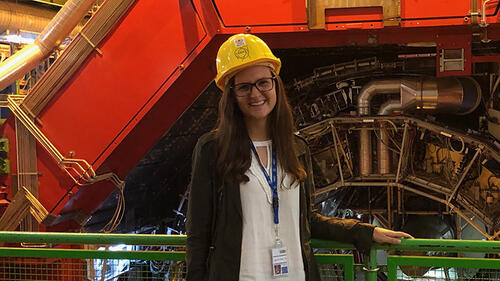
The thing Laura Havener loves about physics is the interactions — the collisions of subatomic particles she studies and the collaborations of hundreds of scientists working on a large experiment.
The North Carolina native, an assistant professor of physics in Yale’s Faculty of Arts and Sciences, gets to experience plenty of both.
As a member of Yale’s Wright Lab, Havener is part of a highly collaborative research community that is exploring the unseen world. As a member of the ALICE (A Large Ion Collider Experiment) collaboration, an international experiment based at the Large Hadron Collider at CERN, in Switzerland, she interacts with an ever-changing array of physicists who use the collider to investigate high energy nuclear physics.
Her own research looks specifically at quantum chromodynamics (QCD), with a focus on understanding the properties and dynamics of the deconfined state of QCD matter — known as the quark-gluon plasma — that is produced in heavy-ion collisions. She studies streams of high-energy particles, called jets, that interact with the quark-gluon plasma.
Havener joined the Yale faculty after a four-year stint as a Yale postdoctoral researcher. When she’s not on campus, she can often be found kicking soccer balls with her young son, David.
In the latest edition of Office Hours, a Q&A series that introduces new Yale faculty members to the broader community, Havener discusses the interactions that have inspired her work and her favorite places on Science Hill.
| title | Assistant Professor of Physics |
|---|---|
| research interest | Experimental high energy nuclear physics |
| prior institution | Columbia University (prior to Yale postdoc) |
| started at yale | July 1, 2023 |
How would you describe your work to a non-physicist?
Laura Havener: What I study is the “strong” nuclear force, the force that holds together the nucleus of atoms. We look at what binds neutrons and protons, by smashing nuclei together at a high energy collider and trying to break them apart.
You are part of ALICE, a large physics experiment based at the Large Hadron Collider at CERN [in Geneva, Switzerland]. What was it like visiting that facility for the first time?
Havener: I was in graduate school when I visited for the first time, and it might have been my favorite experience as a graduate student. I got to sit in the control room where you can see what are called “event displays” — essentially, you’re seeing particle collisions happening in real time. It was absolutely thrilling.
Do you prefer working on big, collaborative projects?
Havener: I tend to feed off the energy and excitement of other people, and I love that I get to work with all sorts of people to solve these hard problems in physics. For me, there is nothing better than spending my day with other people, putting our heads together to answer a question.
Is there a particular part of the scientific discovery process that you like the most?
Havener: Yes, it’s when you see something in the data that is unexpected. This happens a lot, because we’re looking at complicated systems.
At first, when you encounter something unexpected, you think there must be something wrong in the data. Then you dig in and examine it. In those instances when the data was correct, and we had found something new, those have been some of the coolest moments ever for me.
What role models in science have you had along the way?
Havener: Well, I had two family members who were scientists. My Aunt Tammy is a biologist and my Uncle Charlie is a physicist. So the idea of being a scientist wasn’t mysterious or unusual to me.
Later on, the thing that got me interested in high energy physics research was a conference I went to in college. I heard a woman talk about how she studied the strong force and worked with all of these amazing people from around the world. That really resonated with me.
Let’s finish by talking about something closer to home. What is your favorite spot on the Yale campus?
Havener: I love the courtyard on Science Hill that is surrounded by the Yale Science Building and Kline Tower, where Steep café is. I love having lunch there in the summer. Another spot I like is a few steps off that courtyard, where you can look up and see East Rock in the distance.
This article was originally published by Yale News on January 3, 2024. See the link below for the full article.

